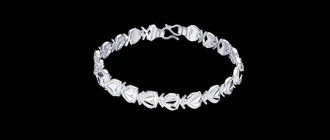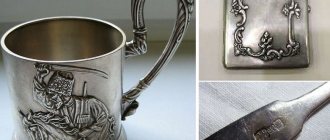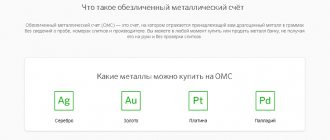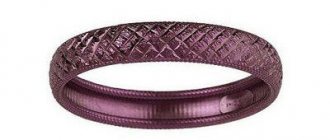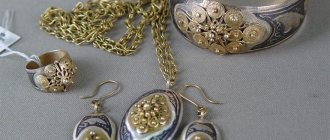Precious metal - gold - is considered a universal raw material, which has found application not only in the jewelry industry, but also in instrument making, medicine and even investment activities. In its pure form, gold can only be found in the form of bank bars, but jewelry is not made from such metal, since gold itself is very ductile and soft. For this reason, the precious metal is combined with other, more durable and wear-resistant components - silver, zinc, platinum and copper. To assess the content of pure gold in a metal alloy, a measure such as a sample is used, which demonstrates the number of grams of precious metal in one kilogram of the alloy. If gold is 500 standard, this means that one kilogram of such an alloy contains 500 grams of pure precious metal.
What kind of sample is this
Gold, as a precious metal, is found only in the form of bars. It is not used for making jewelry due to its high ductility.
To give density and wear resistance, the metal is alloyed with stronger components - zinc, copper, platinum and silver. The ratio of the number of grams of pure gold per kilogram of alloy determines the specific sample.
500-carat gold has a unique marking – ZlSrM 500–100 and a designation in the form of GOST 30649-99.
Composition and properties
500 in the metric system means the number of milligrams of gold per 1 gram of the total mass of the alloy. The silver content in the composition is from 95 to 105 units, copper – 395–405 units. Possible trace amounts of iron and lead.
The proportions of the metal elements determine specific characteristics that indicate the ability of the gold composition to form high-quality castings.
Strength
500-carat gold has low casting properties: the alloy is porous and low in strength due to the significant crystallization interval.
Alloy shade chart
Depending on the ratio of copper and silver in the alloy, the color of 500-carat gold varies from light yellow to orange-red.
Table 1. Shades of 500 gold
| Alloy color | Gold, % | Copper, % | Silver, % |
| Light yellow | 50 | 16,7 | 33,3 |
| Dark yellow | 50 | 33,3 | 16,7 |
| Orange-red | 50 | 42,9 | 7,1 |
The higher the silver content in the alloy, the lighter the products. The predominance of copper in the composition reveals a characteristic red tint.
Brand
A special state sign in the form of a symbol confirming the compliance of the sample with the qualitative composition of the alloy. The hallmark is usually indicated on the inside of the jewelry next to the hallmark. Every country in the world has a single approved sample of the hallmark, which is affixed to all gold products that have passed the test.
How many carats are in this sample?
In the international carat system, gold of the 500th standard corresponds to 12 carats. In Europe, 12 karat alloy is used not only for marking 500, but also for gilding. If the letters FG are indicated next to 12K in the name, then the product is coated with only a thin layer of 500-m alloy.
What standard of gold is considered the best?
Depends on what the noble metal will be used for. For the manufacture of rings, earrings, bracelets and other jewelry, 585 and 750 gold are most suitable, as they will provide the product with the necessary strength and spectacular appearance.
For fine jewelry work, you can use 916 gold, however, provided that the elements made from this alloy are not subject to constant stress and wear. Of course, pure 999 gold is the purest and most expensive, but it is practically useless for jewelry and is used primarily as an investment tool.
Application of this alloy
In Russia and the countries of the former CIS, jewelers often neglect 500-carat gold for making jewelry, but abroad such gold is very valuable. Jewelers give different shades to products by changing the proportions of copper and silver in the composition.
This makes it relevant when used as gilding on silver items, cufflinks, cigarette cases, brooches, stationery and other products. Jewelry of the 500th standard is rare, but this makes it all the more valuable for individual collectors.
Mark 583
This option for checking the quality of precious metal is not much different from 585, but there are still some features:
- The presence of, in addition to zinc, nickel, copper and silver, palladium, which is included in the mixture with the yellow element in this case.
The 583 has a lower amount of yellow metal, so it falls short of 14 karats, which is considered a uniform grade of quality and is accepted throughout the world.The last but not least important difference is that the 583 sample has a star imprinted on it, unlike the 585 sample where there is a kokoshnik.
The pricing policy of brand 583 varies from 2450 to 3000 rubles. However, this price may also apply to 585 samples, it all depends on the location of the product. Due to the fact that the described quality measure is considered only in Russia, therefore, its price can be either equal to the highest threshold or lower than it. Also, the price segment depends on where the product is sold: a pawnshop or a jewelry store.
However, there is a third indicator, namely the supply and demand system, which only works in retail sales, regulated by seasonality.
Despite all kinds of jumps in pricing, this type of yellow metal will never be of the highest quality and will not be able to withstand the test of time for a long time, changing shape and color during use.
583 gold has not been used on the market for a long time to create jewelry, since it has gone out of use since 1994.
However, there are old stocks that were once released by countries that were part of the USSR. These items of jewelry have lost their value due to reduced quality and their combination with semi-precious or cheap precious stones. However, despite the reduced cost and quality, jewelry containing 583 brand is a beautiful addition to a woman’s look.
It is also worth noting that the price of this product allows it to be used for finishing books, cigarette cases, pens, pins, cufflinks, picture frames, threads and many other goods in which the quality indicator of this yellow metal does not matter.
Advantages and disadvantages
The advantages of 500-carat gold include:
- low price per 1 gram;
- uniform distribution of secondary components - copper and silver - in the alloy;
- the ability to give products different shades by changing the proportions of copper and silver up and down.
Disadvantages of the alloy:
- the material is difficult to process due to its low level of flexibility and ductility;
- high porosity, which over time affects the appearance of products;
- unstable to water, chemicals, mechanical influences: subject to darkening in the absence of care, loss of shine.
Gold. All about gold
Gold is the only precious metal with a distinct bright yellow color. “Aurum est metallum pretiosum” (Latin) – “Gold is a precious metal” The history of metals and jewelry is as old as human civilization. Gold mining was mastered by mankind several millennia BC, thanks to its distribution in native form. According to archaeologists, systematic mining began in the Middle East. It was from there that gold jewelry began its offensive, particularly in Egypt. Gold jewelry dating back to the third millennium BC was found there.
A characteristic feature of gold is the highest ductility and malleability of all known noble metals. Gold in its pure form can be easily cut with a knife. It has good electrical and thermal conductivity and high gloss.
- gold density 19.32
- gold atomic number 79
- melting point of gold 1,062°C
- gold hardness according to Brinell 20
- Mohs hardness of gold 2.5
Gold has very high chemical resistance - even when heated, neither oxygen nor sulfur affects it. Gold is resistant to moisture and does not react with acids, salts and alkalis. But it dissolves in some acid mixtures. For example, in “royal vodka” (Latin - Aqua Regis), created by alchemists. It is a mixture of hydrochloric (HCl) and nitric acids (HNO 3
) in a ratio of 3:1. Also in other mixtures of acids - manganese and sulfuric, nitric and sulfuric, in selenic acid when heated. Gold can still dissolve in aqueous solutions of metal cyanide in the presence of oxygen or other catalysts.
Gold easily combines with mercury to form an amalgam. Reacts chemically with bromine, chlorine and iodine.
In nature, gold occurs as a metal in the form of ore (primary, bedrock) and hydrothermal formations. In primary deposits, gold is found in the form of hard-to-see inclusions and inclusions, visible only with the help of special instruments, in primary vein minerals and crystalline rocks. Deposits are classified as industrial if the gold content exceeds 2 grams per ton of rock. Secondary, alluvial formations (sorry for the tautology) were formed as a result of destruction due to the washing out or weathering of ore (primary) deposits. The destruction led to the release of gold from the rock, which, together with the rock, rushes along with running waters, lies along the entire route of runoff in various natural depressions and irregularities along the entire path of its movement following the waters. The high density of gold does not prevent it from moving over long distances and settling at the bottom along the beds of rivers and streams, forming concentrated accumulations of placer gold. Gold in such places has different shapes and sizes, is in the form of irregularly shaped small grains, plates, flakes, distorted crystals, and the like. Placer gold is purer than ore gold and has a higher purity.
Pure gold cannot be found in nature. It always contains impurities, which determine the color of natural gold. Natural gold is a source for obtaining pure gold. Gold extracted from mines is called schlich gold. The purity of spot gold varies and ranges from 500 to 970 purity (50% - 97% pure gold in the total mass). Due to the fact that spot gold consists of particles of different chemical compositions, it requires additional processing and purification from impurities. This is achieved through the use of refining technology in special certified refineries.
Refining (from the French affinage - “to purify”) is a technological process in metallurgy for producing high-purity precious metals by separating impurities from them. The highest degree of purification of gold is achieved by the electrolytic method. Platinum and other platinoids are subjected to chemical purification - dissolution in acids and subsequent isolation from the resulting solution using special reagents.
Pure gold is a relative concept. The purity of gold is expressed by its fineness; there is no 1000th fineness. The grade of pure gold ZL 999 means that its composition is 99.9% gold, and the remaining 0.1% is impurities. The grade of pure gold is Zl 999.9, containing 99.99% gold, the remaining 0.01% being impurities. Impurities can include metals such as silver, copper, lead, bismuth, and iron.
Refined gold is produced in bars of different weights. The degree of purity according to special technical conditions can reach 99.9999%. The bulk of pure gold is used to prepare gold-containing alloys used to produce jewelry, medals, souvenir and commemorative coins, gold leaf and dentures, still popular in some counties, and decorative electroplating. Gold is widely used in instrument making and microelectronics due to its excellent electrical conductivity.
Gold alloys
Even before our era, ancestors used an alloy of gold and silver when minting ancient ancient coins. Electron is a natural alloy of gold and silver. According to ancient sources, the ratio of gold to silver in electron was 4 to 1 or 3 to 1. Recent studies have shown that the pure gold content in electron coins ranges from 16-69%.
Nowadays, noble gold alloys contain the following alloying additives: platinum, silver, copper, palladium, zinc, nickel, cadmium and other metals. Each introduced component has its own effect on the properties of the gold alloy.
The addition of silver gives the gold alloy malleability, ductility and ductility, lowers the melting point, and changes the color of the gold alloy. Increasing the proportion of silver in a gold alloy leads to a change in color. At first, gold turns green, then acquires a yellow-green color. If the proportion of silver in a gold alloy exceeds 30%, the color of the alloy becomes yellow-white and begins to fade as the proportion of silver increases. The white color of a gold alloy will be when the silver content in the alloy is at least 65%.
The addition of copper gives the gold alloy additional hardness, maintaining malleability and ductility, but at the same time worsens the anti-corrosion property. When copper is added to a gold alloy, it acquires a reddish tint, which intensifies with an increase in the percentage of copper - so when the gold alloy contains 14.6% copper, the noble alloy acquires a bright red color.
The addition of palladium maintains the ductility and malleability of the noble alloy, increases the melting point and dramatically changes the color of the gold alloy. If the proportion of palladium in a gold alloy is 10%, the color of the alloy becomes white.
The classification of gold alloys is based on gold fineness . In the production of jewelry, gold alloys of five samples are used - 958, 750, 585, 583 and 375.
Gold content
250 gold
Alloys of this standard are not used in Russia to create jewelry. 250-karat gold is used in foreign jewelry production. These alloys, like Russian ones, are multicomponent; copper, silver, zinc and other metals are used as alloying additives. Due to its low gold content, it is rather a low-grade gold-containing alloy that oxidizes in air and, as a result, is highly susceptible to corrosion and quickly tarnishes.
333 gold
Alloys of this standard are not used in Russia to create jewelry. 333 gold is used in foreign jewelry production. These alloys, like Russian ones, are multicomponent; copper, silver, zinc and other metals are used as alloying additives. Due to its low gold content, it is rather a gold-containing alloy that oxidizes in air and, as a result, quickly tarnishes. Used in the production of cheap jewelry for mass demand.
375 gold*
375 gold alloys are used in the production of inexpensive jewelry. It comes in various color shades, from yellow to red. Mainly used in the production of cheap wedding rings. Jewelry made of 375 gold is not very popular due to its low consumer qualities - it quickly loses its shine and attractive appearance. Pale yellow alloys begin to turn green, and 375 grade alloys with reddish shades darken and acquire a brown tint.
500 gold
Currently, 500-karat gold does not find practical use in the production of jewelry, mainly due to unsatisfactory casting properties. Copper and silver are used as alloying additives, the percentage of which determines the possible colors of the alloy - from greenish to red.
583 gold
Jewelry made of 583 gold was extremely popular in the Soviet Union; it is a kind of gold standard of the former USSR.
585 gold*
The 585 gold standard, which replaced the 583 standard, is now widely used in the production of jewelry. New production technologies, such as casting, weaving, drawing and others, are developed using gold of this standard. A wide variety of jewelry is mass produced from 585 gold - rings, earrings, pendants, bracelets, chains, tie clips, cufflinks, pendants, brooches. 585 gold is slightly susceptible to environmental influences, practically does not lose its presentation and does not tarnish. Pieces of this standard are presented in a wide color range - from white gold to red in all possible color shades.
750 gold*
Due to the high gold content, 750 alloys have high technological and consumer properties. Also available in a wide range of colors. Starting from 750 fineness, gold alloys are resistant to environmental influences. 18k white gold is used in the production of expensive diamond jewelry
958 gold*
A high-grade gold alloy that practically does not oxidize, but due to its softness it is easily scratched. 958 gold jewelry needs to be polished frequently to maintain its shine.
960 gold leaf
Gold leaf is usually used for decorative purposes. A popular method of gilding various objects (artworks, architectural and decorative elements). Also used in the food industry (food additive code E175). Gold leaf refers to the thinnest (usually about 100 nanomicrons) gold sheets. Created gold is leaves of 960 gold leaf turned into powder, even dust. To attach crafted and gold leaf to the surface of objects, special adhesives based on linseed oil are used. Leaf is the thinnest plates of silver, gold, tin, copper and some other metals, used for decorative finishing of any products. Silver and gold leaf are the most skillful imitations of silver and gold.
999 gold*
Jewelry made of gold of this standard is very rare and you will not see it in the windows of jewelry stores. Due to the insignificant content of impurities (up to 0.01%), such gold is also called “four nines”. Used in the production of bank bullion.
*- Samples of gold , most commonly used in the production of gold jewelry. Decree of the Government of the Russian Federation No. 643 of June 18, 1999 “On the procedure for testing and branding products made of precious metals” regulates the procedure for testing and branding jewelry. It is still in force and allows the use of gold samples in Russian jewelry production: 375, 500, 585, 750, 958 and 999.
Gold alloys can also be classified based on color.
Gold color
Red gold
This is a popular and widespread precious alloy of 585 gold in our country. An established synonym for red gold is Russian gold. The traditional red gold alloy is produced by melting 58.3% pure gold and 41.7% copper. When silver, palladium and nickel are added in varying proportions, the color of red gold acquires a distinct pink tint.
Yellow gold
The main difference between yellow gold and the traditional red gold for our country is determined only by the composition of the alloy; there is as much pure gold in the yellow alloy as in the red gold alloy. Yellow gold is represented by alloys of 585 and 750 samples. The color shades of yellow gold depend on the proportion of silver. The higher the proportion of silver in a yellow gold alloy, the paler the shade. This is more typical for jewelry of foreign origin.
White gold
Precious alloy of 585 and 750 gold. It acquires white color in various shades by adding silver, platinum, palladium and nickel. Currently, modern white gold alloys do not contain nickel, which is an allergen that causes contact dermatitis in many people. White gold is widely used in the production of diamond jewelry, enhancing the play of light and highlighting the beauty of the stones. To give a noble whiteness, white gold is coated with a layer of rhodium using the galvanization method. This technology is called rhodium plating. Rhodium is a bluish-white platinum group metal that is 5 times harder than gold. This property of rhodium gives white gold greater wear resistance - white gold jewelry retains its shine for a long time and is less scratched.
Black gold
Gold jewelry undergoes special processing to give the gold alloy an unusual black color of various shades. Typically, two technologies are used to achieve this goal:
- Gold jewelry is coated with a layer of ruthenium or black rhodium using the electroplating method. This method allows you to vary the color of the gold alloy coating in a wide range from gray to black.
- gold jewelry is covered with a layer of amorphous (the molecules are arranged randomly, without a crystalline structure) carbon. This method is used in the watch industry to produce black gold cases.
- a black gold alloy is obtained by melting 75% pure gold, 15% cobalt and 10% chromium, after which the surface of the resulting jewelry is further oxidized at a temperature of 700-950°C.
Brown gold
Jewelry made from gold undergoes additional special chemical treatment to give the gold alloy an unusual brown color. Basically, to achieve this goal, alloys of gold 585 and 750 with a high content of the alloying component - copper are used. The result of this treatment is that a dense chemical compound of black-brown color is formed on the surface of the jewelry. To impart stability to the resulting color coating, the gold alloy is subjected to special treatment several times.
Purple-violet gold (“amethyst gold”)*
Intermetallic compound (metallide) of gold (78.5%) with aluminum (21.5%).
Blue gold*
Intermetallic compound (metallide) of gold with indium.
Dark green gold*
Intermetallic compound (metallide) of gold with rubidium.
Olive gold*
Intermetallic compound (metallide) of gold with potassium.
* - metallides have a very intense and unusual color and are quite brittle, which makes mechanical processing difficult. Gold metallides are mainly used in the manufacture of inserts for jewelry and are shaped into precious stones during processing.
We present the dependence of the colors of gold used in the production of jewelry on the proportion and composition of alloying additives.
Matching the color of gold jewelry to the composition of the ligature*
| gold alloy color | try | gold | silver | copper | palladium |
| composition of the ligature | |||||
| yellow gold | 750 | 75 % | 17 % | 8 % | — |
| pink gold | 750 | 75 % | 12.5 % | 12.5 % | — |
| White gold | 750 | 75 % | 5 % | — | 20 % |
| yellowish gold | 585 | 58.5 % | 28 % | 13.5 % | — |
| yellow-green gold | 585 | 58.5 % | 38.25 % | 3.25 % | — |
| yellow gold | 585 | 58.5 % | 18.75 % | 22.75 % | — |
| pink gold | 585 | 58.5 % | 9 % | 32.5 % | — |
| orange gold | 333 | 33.3 % | 53.4 % | 13.3 % | — |
| red gold | 333 | 33.3 % | 9.5 % | 57.2 % | — |
* - the table shows the basic ratios of alloying additives. Modern technologies for the production of jewelry gold alloys use not only three-component ligatures, which determines a wider color range of gold jewelry.
If you find an error or typo, please select a piece of text and press Ctrl+Enter.
0 0 votes
Article rating
Where can you buy or sell
Large Russian jewelry stores do not carry 500-carat gold jewelry. Products can be purchased at specialized auctions, pawn shops, and private workshops.
You can sell jewelry in pawn shops and jewelry auctions. On such sites you can post a photo and sell the product at a higher price.
How much does 1 gram of gold of this standard cost today?
On average in Russia, Belarus and Ukraine, the price for 1 gram of 500-carat gold starts from 2,500 rubles. If you want to sell jewelry in a pawnshop, then for 1 gram you can get 600–800 rubles.
This is 2 times cheaper than when selling the most popular 585 precious metal. You can try your luck at online auctions, where a collector will like your jewelry and buy it at a much higher price than pawn shops offer.
Recommendations for care, cleaning and storage
Key features that allow you to preserve the original appearance of gold products for a long time include:
- neat wear;
- proper storage;
- timely removal of contaminants.
Avoid mechanical damage, contact with water, alkaline detergents, compounds containing iodine and chlorine of 500-carat gold products.
Before applying creams and ointments, especially those containing mercury, you need to remove jewelry. The same is recommended when performing household chores, cosmetic or medical procedures, or during sports activities.
You can clean gold jewelry only with special wipes and solutions. In jewelry workshops you can order professional and safe metal cleaning, which will remove any contamination.
Jewelry with inserts made of precious stones requires especially careful wear and care. Each gem has its own care recommendations. All stones, without exception, must be protected from shock and abrasion. Some of them lose their appearance from ultraviolet radiation, while others suffer from moisture.
Why does 500-carat gold darken?
Based on the fact that 500 gold contains a high concentration of copper in its composition, it is highly susceptible to oxidation. The main problems of gold of this sample:
- High degree and rate of oxidation;
- Loss of color;
- Lack of wear resistance.
Since this gold is practically not used as jewelry, problems with wearing it on the body may also not arise. However, do not forget that the high copper content in 500 gold alloy can negatively affect human skin, as it leaves behind unpleasant black marks. In addition, gold of this standard does not interact well with various detergents, which is why if you have a ring of this standard, you should use household chemicals with gloves. Otherwise, your jewelry may quickly lose its beauty, color and shine. If you have accessories of this type, over time they may also lose their original appearance if they are not properly cared for.
How to clean a product made from such an alloy yourself
Cleaning items or jewelry made of 500 fineness is not so easy, and simple methods of wiping the item with a woolen rag or soda solution are not enough. There are several ways to clean this type of gold or the gold product that is made from it from contamination or oxidation.
For the first method, you will need a solution of ammonia with warm water and a small amount of washing powder. You can definitely find all the necessary ingredients at home, since these are substances that are in demand in the household. To clean your product, you will need to regularly place it in this solution. It is important that the product is not in the solution for more than 2 hours. After completing the procedure, it is enough to rinse it under running cold water.
For the second method, you will also need some home remedies such as ammonia, hydrogen peroxide, warm water and liquid water. You need to do the same procedure with this solution.
Tips for choosing gold jewelry
When choosing jewelry, it is important to decide for what occasion it should be suitable: for a wedding, an official or work occasion. If you are choosing a gift for a loved one, it is very important to know his taste. The range of products is huge, as is the range of prices.
4 tips for choosing gold jewelry:
- pay attention to the mark on the inside of the jewelry. Next to it there should be a stamp confirming the authenticity of the sample in accordance with the qualitative composition of the metal. Each country has its own symbols. If it is a Russian manufacturer, then the stamp will be in the form of a lady in a kokoshnik in the right profile. If the jewelry was made in the USSR, then its authenticity is confirmed by the characteristic image of a star and a hammer and sickle;
- make sure you have a sample. The mark can be anything from 750 to 333. Samples below the extreme mark are placed on costume jewelry;
- eliminate unevenness and abrasions. If it is a worn or antique ring, then this type is acceptable. However, if you notice scratches or an uneven cut on a piece of jewelry from a jewelry store, this may indicate a low-quality alloy or even a fake;
- exclude fake. After checking the sample, the presence of a mark and assessing the general appearance, examine the product tag. It must contain all the information about weight, sample, manufacturer, name, composition and cost.
Reviews
What do they say online about the 500th purity of gold? Most of the reviews are negative, which is easily explained.
If you have any doubts whether the price of the jewelry corresponds to the declared marking, it is better to contact not one appraiser, but several, and compare their opinions. Parts of the same factory jewelry cannot be of different samples, or it is a low-quality product.
Alas, the 500th sample often appears in angry reviews of stores.
What can I say? Be vigilant, check the certificates for a bracelet, chain or ring as much as possible, and if in doubt, postpone the purchase.
How to distinguish 500 sample from a fake
This product is not particularly different in authenticity testing methods from other gold samples. They are all checked using almost the same methods. Since this material has a fairly high concentration of copper, it is quite easy to determine it simply by biting your teeth; this product, in combination with silver, gold and copper, should not bend under a light bite. This will be a guarantee that this product is genuine and they are not trying to deceive you. If, however, it bends or a small dent appears, they are trying to deceive you.
Well, a simple test using a ceramic product, cup or plate. You just need to lightly rub the gold item along the bottom of the cup and you will see a yellow mark, which means that this is a real item. In cases of fake, the trace will be black or gray.




